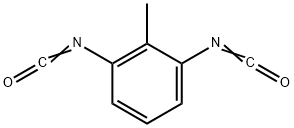| Identification | More | [Name]
2-METHYL-M-PHENYLENE DIISOCYANATE | [CAS]
91-08-7 | [Synonyms]
2,6-DIISOCYANATOTOLUENE
2,6-TDI
2,6-TOLUENEDIISOCYANATE
2,6-TOLYLENE DIISOCYANATE
2-METHYL-1,3-PHENYLENE DIISOCYANATE
2-METHYL-M-PHENYLENE DIISOCYANATE
TOLUENE-2,6-DIISOCYANATE
TOLYLENE 2,6-DIISOCYANATE
1,3-diisocyanato-2-methyl-benzen
1,3-Diisocyanato-2-methylbenzene
1,3-diisocyanato-2-methyl-Benzene
2,6-diisocyanato-1-methyl-benzen
2,6-Diisocyanato-1-methylbenzene
2,6-Toluenediiosocyanate
2-Methyl-meta-phenylene diisocyanate
2-Methyl-meta-phenylene isocyanate
2-methyl-meta-phenylenediisocyanate
2-methyl-meta-phenyleneisocyanate
2-Methyl-m-phenylene isocyanate
2-methyl-m-phenyleneisocyanate | [EINECS(EC#)]
202-039-0 | [Molecular Formula]
C9H6N2O2 | [MDL Number]
MFCD00002010 | [Molecular Weight]
174.16 | [MOL File]
91-08-7.mol |
| Chemical Properties | Back Directory | [Appearance]
colourless liquid | [Melting point ]
13°C | [Boiling point ]
129-133 °C18 mm Hg(lit.) | [density ]
1.225 g/mL at 25 °C(lit.)
| [vapor pressure ]
2.78Pa at 25℃ | [refractive index ]
n20/D 1.571(lit.)
| [Fp ]
>230 °F
| [storage temp. ]
−20°C
| [form ]
Liquid | [color ]
Clear colorless to light yellow | [Stability:]
Stability Reacts violently with water. Reacts very rapidly with compounds containing an active hydrogen, such as amines, alcohols and acids. Polymerizes rapidly in the presence of base. Combustible. Incompatible with strong oxidizing agents. | [Water Solubility ]
It hydrolyzes in water. | [Sensitive ]
Moisture Sensitive | [BRN ]
2211546 | [Exposure limits]
ACGIH: TWA 0.001 ppm; STEL 0.005 ppm (Skin) | [LogP]
3.74 | [CAS DataBase Reference]
91-08-7(CAS DataBase Reference) | [EPA Substance Registry System]
Toluene-2,6-diisocyanate (91-08-7) |
| Safety Data | Back Directory | [Hazard Codes ]
T+ | [Risk Statements ]
R26:Very Toxic by inhalation.
R36/37/38:Irritating to eyes, respiratory system and skin .
R40:Limited evidence of a carcinogenic effect.
R42/43:May cause sensitization by inhalation and skin contact .
R52/53:Harmful to aquatic organisms, may cause long-term adverse effects in the aquatic environment . | [Safety Statements ]
S23:Do not breathe gas/fumes/vapor/spray (appropriate wording to be specified by the manufacturer) .
S36/37:Wear suitable protective clothing and gloves .
S45:In case of accident or if you feel unwell, seek medical advice immediately (show label where possible) .
S61:Avoid release to the environment. Refer to special instructions safety data sheet . | [RIDADR ]
UN 2078 6.1/PG 2
| [WGK Germany ]
2
| [RTECS ]
CZ6310000
| [F ]
8-10-19-21 | [Autoignition Temperature]
>1148 °F | [TSCA ]
Yes | [HazardClass ]
6.1 | [PackingGroup ]
II | [HS Code ]
29291090 | [Safety Profile]
Confirmed carcinogen.
Poison by ingestion and inhalation. Human
systemic effects by inhalation: olfactory, eye,
and pulmonary changes. Flammable liquid.
When heated to decomposition it emits
toxic fumes of NOx. See also CYANATES. | [Hazardous Substances Data]
91-08-7(Hazardous Substances Data) |
| Hazard Information | Back Directory | [General Description]
Liquid. Used in the manufacture of polyurethane foams, elastomers, and coatings; crosslinking agent for nylon 6. | [Reactivity Profile]
TOLUENE-2,6-DIISOCYANATE reacts violently with amines, alcohols, bases and warm water, causing fire and explosion hazards. [Handling Chemcials Safely 1980. p. 907]. Reaction with water to form Carbon Dioxide [Merck 11th ed. 1989]. | [Health Hazard]
Classified as slightly toxic orally. Probable oral lethal dose in humans is 5 to 15 g/kg or between 1 pint and 1 quart for a 70 (l50 lb.) person. Particularly poisonous when breathed. This is among the most poisonous of isocyanates. Acute and chronic exposures to low concentrations may produce asthmatic attacks. | [Fire Hazard]
When heated to decomposition, TOLUENE-2,6-DIISOCYANATE emits toxic fumes of nitrogen oxides. Ventilation should be adequate. If polyurethane products are heated, protection against isocyanate release is necessary. Avoid decomposing heat. | [Chemical Properties]
colourless liquid | [Uses]
2,6-TDI may be used as a reference standard for the quantification of residual 2,6-TDI in foam samples using high performance liquid chromatography coupled to coordination-ionspray tandem mass spectrometry (HPLC-CIS-MS/MS). | [Uses]
2-Methyl-m-phenylene Diisocyanate is used in method for preparing breathable sweat-absorbing EVA foam shoe material. | [Definition]
ChEBI: A toluene meta-diisocyanate in which the isocyanato groups are at positions 2 and 6 relative to the methyl group on the benzene ring. | [Synthesis Reference(s)]
The Journal of Organic Chemistry, 60, p. 257, 1995 DOI: 10.1021/jo00106a044 | [Flammability and Explosibility]
Nonflammable | [Purification Methods]
It is purified by fractional distillation in a vacuum. Store it under N2 in sealed dark ampoules as it is water and light sensitive. Like the preceding 2,4-isomer, it has a sharp pungent odour, is TOXIC and is IRRITATING TO THE EYES. [Beilstein 13 IV 259.] | [Toxics Screening Level]
The Initial Threshold Screening Level (ITSL) for TDI is 0.07 μg/m3 (annual average).
The Second ITSL for TDI is 0.4 μg/m3 (8-hr average).
The Initial Risk Screening Level for TDI is 0.03 μg/m3 (annual average).
The Secondary Risk Screening Level for TDI is 0.3 μg/m3 (annual average) |
|
| Company Name: |
Alfa Aesar
|
| Tel: |
400-6106006 |
| Website: |
http://chemicals.thermofisher.cn |
| Company Name: |
Energy Chemical
|
| Tel: |
021-021-58432009 400-005-6266 |
| Website: |
http://www.energy-chemical.com |
| Company Name: |
Spectrum Chemical Manufacturing Corp.
|
| Tel: |
021-021-021-67601398-809-809-809 15221380277 |
| Website: |
www.spectrumchemical.com/oa_html/index.jsp?minisite=10020&respid=22372&language=us |
|





